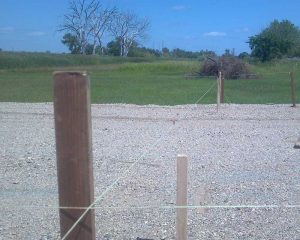Thank you to reader KEN in BRECKSVILLE who writes:
“How do you secure the posts in the ground when you have a steep slope requiring longer posts in the back?
The rear of a 48′ deep pole barn has about a 6′ drop in ground level from the front end. A retaining wall and 57 stone fill are planned to be used to level the site. The wall height is 16′ and width is 36′. The rear posts will need to be 6′ longer than the front to secure the posts in virgin ground not filled in with leveling stone. At a 16′ wall height I will need posts at least 20′ long for the front and 26′ long for the back. Do you provide posts this length or is it better to use shorter posts in the back to secure in the ground and attach additional posts on top of these posts for the wall heights.”
Before answering, I (knowing not nearly enough about stone) had to research 57 stone fill.
 Contrary to popular opinion, there’s more than one type of gravel and selecting proper size and style is crucial to project success. One most commonly used and versatile type of gravel is #57 crushed.
Contrary to popular opinion, there’s more than one type of gravel and selecting proper size and style is crucial to project success. One most commonly used and versatile type of gravel is #57 crushed.
When considering different gravel or crushed stone types, a number indicates sieve size a material is screened through.
A #57 sieve produces gravel materials approximately 1” – 1.5” in size. To put this into perspective, you can expect gravel in this size family to be around the same size as nickels and quarters.
Depending on where it was manufactured, #57 crushed gravel may be comprised of granite, limestone, trap rock. Because this type of gravel is so common, it is highly affordable.
Without using DGA (Dense Grade Aggregate comprised primarily of ¾” minus crushed stone aggregate combined with a careful and precise mixture of stone dust as a means of reducing void contents), or a similar material, you will find this is not an ideal sized gravel for creating an extremely firm, compact surface.
My answer to KEN:
We can get columns over 60′ in length (I have them up to 50′ long on my own personal shouse in South Dakota). Attempting to attach a post on top of a post is not a good structural solution, so I would eliminate it as a consideration.
My recommendation would be to build your retaining wall first. Place fill in maximum six inch lifts, compacting each layer to a minimum of 90% of a Modified Proctor Density before adding the next layer (you will need to do this sort of compaction to support a slab on grade properly anyhow). You can then treat your fill as if it is undisturbed soil and would not require longer columns. Your idea of using 57 stone fill is probably not going to yield a good result, as it is not ideally sized to create an extremely firm, compact surface (what you want).






